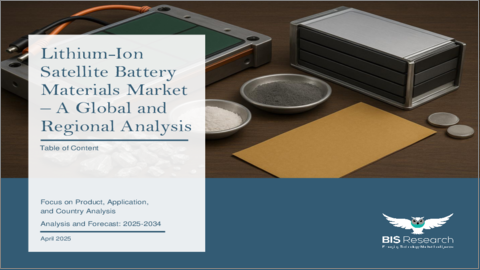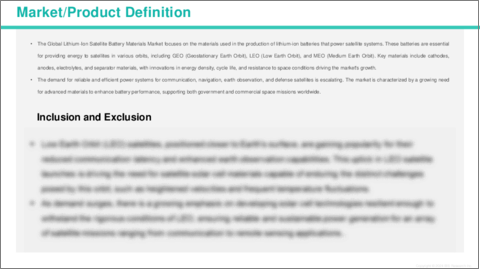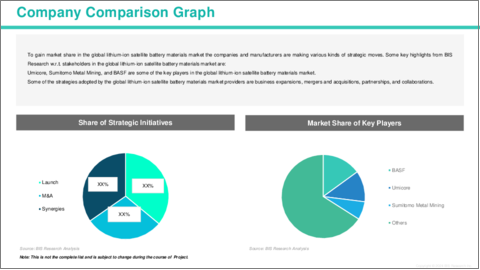|
|
市場調査レポート
商品コード
1718911
衛星用リチウムイオン電池材料の世界市場:製品・用途・国別の分析・予測 (2025-2034年)Lithium-Ion Satellite Battery Materials Market - A Global and Regional Analysis: Focus on Product, Application, and Country Analysis - Analysis and Forecast, 2025-2034 |
||||||
カスタマイズ可能
|
|||||||
| 衛星用リチウムイオン電池材料の世界市場:製品・用途・国別の分析・予測 (2025-2034年) |
|
出版日: 2025年05月05日
発行: BIS Research
ページ情報: 英文 120 Pages
納期: 1~5営業日
|
全表示
- 概要
- 図表
- 目次
世界の衛星用リチウムイオン電池材料の市場規模は、衛星用途における高度なエネルギー貯蔵ソリューションに対する需要の高まりによって牽引されています。
これらの電池は高いエネルギー密度、長いライフサイクル、信頼性を提供し、宇宙ミッションに不可欠なものとなっています。衛星用リチウムイオン電池材料市場は、技術の進歩、衛星打ち上げの増加、より持続可能なエネルギーソリューションへのシフトの影響を受けています。主な材料には、コバルト酸リチウム、リン酸鉄リチウム、グラファイトなどがあります。特に通信、航法、地球観測などの宇宙分野の拡大に伴い、衛星用リチウムイオン電池材料市場は今後数年で大幅な成長が見込まれています。
市場ライフサイクルステージ
| 主要市場統計 | |
|---|---|
| 予測期間 | 2025-2034年 |
| 2025年評価 | 17億米ドル |
| 2034年予測 | 25億7,000万米ドル |
| CAGR | 4.72% |
世界のリチウムイオン衛星用電池材料の市場は、現在ライフサイクルの成長期にあります。宇宙技術の進歩、効率的な衛星用電源ソリューションへの需要の増加、持続可能なエネルギー源への転換が、この市場の急速な拡大を後押ししています。リチウムイオン電池の化学構造における革新やエネルギー密度の向上が、市場の需要をさらに高めています。宇宙ミッションの頻度が増し、商業衛星の打ち上げが活発になる中で、この市場は今後も安定した成長が見込まれており、技術の進化に伴ってさらに拡大する可能性があります。
当レポートでは、世界の衛星用リチウムイオン電池材料の市場を調査し、主要動向、市場影響因子の分析、法規制環境、技術・特許の動向、ケーススタディ、市場規模の推移・予測、各種区分・地域/主要国別の詳細分析、競合情勢、主要企業のプロファイルなどをまとめています。
目次
エグゼクティブサマリー
第1章 市場:業界展望
- 動向:現状と将来への影響評価
- ステークホルダー分析
- 使用事例
- エンドユーザーと購入基準
- 市場力学の概要
- 市場促進要因
- 市場抑制要因
- 市場機会
- 規制および政策の影響分析
- 特許分析
- スタートアップの情勢
- 総潜在市場
- 投資情勢と研究開発動向
- 将来展望と市場ロードマップ
- サプライチェーン分析
- バリューチェーン分析
- 世界価格分析
- 業界の魅力
第2章 世界の衛星用リチウムイオン電池材料市場:用途別
- 用途のセグメンテーション
- 用途のサマリー
- 世界の衛星用リチウムイオン電池材料市場 (用途別)
- GEO衛星用リチウムイオン電池
- LEO衛星用リチウムイオン電池
- MEO衛星用リチウムイオン電池
第3章 世界の衛星用リチウムイオン電池材料市場:製品別
- 製品セグメンテーション
- 製品サマリー
- 世界の衛星用リチウムイオン電池材料市場 (製品タイプ別)
- カソード材料
- アノード材料
- その他
第4章 世界の衛星用リチウムイオン電池材料市場:地域別
- 世界の衛星用リチウムイオン電池材料市場 (地域別)
- 北米
- 地域概要
- 市場成長推進要因
- 市場課題
- 主要企業
- 用途
- 製品
- 北米 (国別)
- 欧州
- 地域概要
- 市場成長推進要因
- 市場課題
- 主要企業
- 用途
- 製品
- 欧州 (国別)
- アジア太平洋
- 地域概要
- 市場成長推進要因
- 市場課題
- 主要企業
- 用途
- 製品
- アジア太平洋 (国別)
- その他の地域
- 地域概要
- 市場成長推進要因
- 市場課題
- 主要企業
- 用途
- 製品
- その他の地域 (地域別)
第5章 市場:競合ベンチマーキングと企業プロファイル
- 次のフロンティア
- 地理的評価
- 企業プロファイル
- Umicore
- Sumitomo Metal Mining
- BASF
- LG Chem
- EcoPro BM
- Toda Kogyo
- Nichia Corporation
- Hitachi Chemical
- BTR New Material
- Sila Nanotechnologies
- Nexeon
- Altairnano
- Toshiba
- Ningbo Shanshan
- South Manganese Group
- JGC
- その他の主要企業
第6章 調査手法
List of Figures
- Figure 1: Lithium-Ion Satellite Battery Materials Market (by Scenario), $Million, 2025, 2028, and 2034
- Figure 2: Lithium-Ion Satellite Battery Materials Market (by Region), $Million, 2024, 2027, and 2034
- Figure 3: Lithium-Ion Satellite Battery Materials Market (by Application), $Million, 2024, 2027, and 2034
- Figure 4: Lithium-Ion Satellite Battery Materials Market (by Product), $Million, 2024, 2027, and 2034
- Figure 5: Competitive Landscape Snapshot
- Figure 6: Supply Chain Analysis
- Figure 7: Value Chain Analysis
- Figure 8: Patent Analysis (by Country), January 2021-April 2025
- Figure 9: Patent Analysis (by Company), January 2021-April 2025
- Figure 10: Impact Analysis of Market Navigating Factors, 2024-2034
- Figure 11: U.S. Lithium-Ion Satellite Battery Materials Market, $Million, 2024-2034
- Figure 12: Canada Lithium-Ion Satellite Battery Materials Market, $Million, 2024-2034
- Figure 13: Mexico Lithium-Ion Satellite Battery Materials Market, $Million, 2024-2034
- Figure 14: Germany Lithium-Ion Satellite Battery Materials Market, $Million, 2024-2034
- Figure 15: France Lithium-Ion Satellite Battery Materials Market, $Million, 2024-2034
- Figure 16: Italy Lithium-Ion Satellite Battery Materials Market, $Million, 2024-2034
- Figure 17: Spain Lithium-Ion Satellite Battery Materials Market, $Million, 2024-2034
- Figure 18: U.K. Lithium-Ion Satellite Battery Materials Market, $Million, 2024-2034
- Figure 19: Rest-of-Europe Lithium-Ion Satellite Battery Materials Market, $Million, 2024-2034
- Figure 20: China Lithium-Ion Satellite Battery Materials Market, $Million, 2024-2034
- Figure 21: Japan Lithium-Ion Satellite Battery Materials Market, $Million, 2024-2034
- Figure 22: India Lithium-Ion Satellite Battery Materials Market, $Million, 2024-2034
- Figure 23: South Korea Lithium-Ion Satellite Battery Materials Market, $Million, 2024-2034
- Figure 24: Rest-of-Asia-Pacific Lithium-Ion Satellite Battery Materials Market, $Million, 2024-2034
- Figure 25: South America Lithium-Ion Satellite Battery Materials Market, $Million, 2024-2034
- Figure 26: Middle East and Africa Lithium-Ion Satellite Battery Materials Market, $Million, 2024-2034
- Figure 27: Strategic Initiatives (by Company), 2021-2025
- Figure 28: Share of Strategic Initiatives, 2021-2025
- Figure 29: Data Triangulation
- Figure 30: Top-Down and Bottom-Up Approach
- Figure 31: Assumptions and Limitations
List of Tables
- Table 1: Market Snapshot
- Table 2: Opportunities across Region
- Table 3: Trends Overview
- Table 4: Lithium-Ion Satellite Battery Materials Market Pricing Forecast, 2024-2034
- Table 5: Application Summary (by Application)
- Table 6: Product Summary (by Product)
- Table 7: Lithium-Ion Satellite Battery Materials Market (by Region), $Million, 2024-2034
- Table 8: North America Lithium-Ion Satellite Battery Materials Market (by Application), $Million, 2024-2034
- Table 9: North America Lithium-Ion Satellite Battery Materials Market (by Product), $Million, 2024-2034
- Table 10: U.S. Lithium-Ion Satellite Battery Materials Market (by Application), $Million, 2024-2034
- Table 11: U.S. Lithium-Ion Satellite Battery Materials Market (by Product), $Million, 2024-2034
- Table 12: Canada Lithium-Ion Satellite Battery Materials Market (by Application), $Million, 2024-2034
- Table 13: Canada Lithium-Ion Satellite Battery Materials Market (by Product), $Million, 2024-2034
- Table 14: Mexico Lithium-Ion Satellite Battery Materials Market (by Application), $Million, 2024-2034
- Table 15: Mexico Lithium-Ion Satellite Battery Materials Market (by Product), $Million, 2024-2034
- Table 16: Europe Lithium-Ion Satellite Battery Materials Market (by Application), $Million, 2024-2034
- Table 17: Europe Lithium-Ion Satellite Battery Materials Market (by Product), $Million, 2024-2034
- Table 18: Germany Lithium-Ion Satellite Battery Materials Market (by Application), $Million, 2024-2034
- Table 19: Germany Lithium-Ion Satellite Battery Materials Market (by Product), $Million, 2024-2034
- Table 20: France Lithium-Ion Satellite Battery Materials Market (by Application), $Million, 2024-2034
- Table 21: France Lithium-Ion Satellite Battery Materials Market (by Product), $Million, 2024-2034
- Table 22: Italy Lithium-Ion Satellite Battery Materials Market (by Application), $Million, 2024-2034
- Table 23: Italy Lithium-Ion Satellite Battery Materials Market (by Product), $Million, 2024-2034
- Table 24: Spain Lithium-Ion Satellite Battery Materials Market (by Application), $Million, 2024-2034
- Table 25: Spain Lithium-Ion Satellite Battery Materials Market (by Product), $Million, 2024-2034
- Table 26: U.K. Lithium-Ion Satellite Battery Materials Market (by Application), $Million, 2024-2034
- Table 27: U.K. Lithium-Ion Satellite Battery Materials Market (by Product), $Million, 2024-2034
- Table 28: Rest-of-Europe Lithium-Ion Satellite Battery Materials Market (by Application), $Million, 2024-2034
- Table 29: Rest-of-Europe Lithium-Ion Satellite Battery Materials Market (by Product), $Million, 2024-2034
- Table 30: Asia-Pacific Lithium-Ion Satellite Battery Materials Market (by Application), $Million, 2024-2034
- Table 31: Asia-Pacific Lithium-Ion Satellite Battery Materials Market (by Product), $Million, 2024-2034
- Table 32: China Lithium-Ion Satellite Battery Materials Market (by Application), $Million, 2024-2034
- Table 33: China Lithium-Ion Satellite Battery Materials Market (by Product), $Million, 2024-2034
- Table 34: Japan Lithium-Ion Satellite Battery Materials Market (by Application), $Million, 2024-2034
- Table 35: Japan Lithium-Ion Satellite Battery Materials Market (by Product), $Million, 2024-2034
- Table 36: India Lithium-Ion Satellite Battery Materials Market (by Application), $Million, 2024-2034
- Table 37: India Lithium-Ion Satellite Battery Materials Market (by Product), $Million, 2024-2034
- Table 38: South Korea Lithium-Ion Satellite Battery Materials Market (by Application), $Million, 2024-2034
- Table 39: South Korea Lithium-Ion Satellite Battery Materials Market (by Product), $Million, 2024-2034
- Table 40: Rest-of-Asia-Pacific Lithium-Ion Satellite Battery Materials Market (by Application), $Million, 2024-2034
- Table 41: Rest-of-Asia-Pacific Lithium-Ion Satellite Battery Materials Market (by Product), $Million, 2024-2034
- Table 42: Rest-of-the-World Lithium-Ion Satellite Battery Materials Market (by Application), $Million, 2024-2034
- Table 43: Rest-of-the-World Lithium-Ion Satellite Battery Materials Market (by Product), $Million, 2024-2034
- Table 44: South America Lithium-Ion Satellite Battery Materials Market (by Application), $Million, 2024-2034
- Table 45: South America Lithium-Ion Satellite Battery Materials Market (by Product), $Million, 2024-2034
- Table 46: Middle East and Africa Lithium-Ion Satellite Battery Materials Market (by Application), $Million, 2024-2034
- Table 47: Middle East and Africa Lithium-Ion Satellite Battery Materials Market (by Product), $Million, 2024-2034
- Table 48: Market Share
Global Lithium-Ion Satellite Battery Materials Market: Industry Overview
The global lithium-ion satellite battery materials market is driven by the increasing demand for advanced energy storage solutions in satellite applications. These batteries offer high energy density, longer life cycles, and reliability, making them essential for space missions. The lithium-ion satellite battery materials market is influenced by technological advancements, growing satellite launches, and the shift towards more sustainable energy solutions. Key materials include lithium cobalt oxide, lithium iron phosphate, and graphite. As the space sector expands, particularly in communication, navigation, and Earth observation, the lithium-ion satellite battery materials market is expected to experience substantial growth in the coming years.
Market Lifecycle Stage
| KEY MARKET STATISTICS | |
|---|---|
| Forecast Period | 2025 - 2034 |
| 2025 Evaluation | $1.70 Billion |
| 2034 Forecast | $2.57 Billion |
| CAGR | 4.72% |
The global lithium-ion satellite battery materials market is currently in the growth stage of its lifecycle. Driven by advancements in space technology, increasing demand for efficient satellite power solutions, and the shift towards sustainable energy sources, this market is expanding rapidly. Innovations in lithium-ion battery chemistry and improvements in energy density are fueling market demand. As space missions become more frequent and commercial satellite launches rise, the market is expected to experience steady growth, with potential for further expansion in the coming years as technology continues to evolve.
Global Lithium-Ion Satellite Battery Materials Market Segmentation:
Segmentation 1: by Application
- GEO Satellites Lithium Ion Battery
- LEO Satellites Lithium Ion Battery
- MEO Satellites Lithium Ion Battery
LEO satellites lithium ion battery is one of the prominent application segments in the global lithium-ion satellite battery materials market.
Segmentation 2: by Product Type
- Cathodes Material
- Anodes Material
- Others
The global lithium-ion satellite battery materials market is estimated to be led by the cathodes material.
Segmentation 3: by Region
- North America - U.S., Canada, and Mexico
- Europe - Germany, France, Italy, Spain, U.K., and Rest-of-Europe
- Asia-Pacific - China, Japan, South Korea, India, and Rest-of-Asia-Pacific
- Rest-of-the-World - South America and Middle East and Africa
In the global lithium-ion satellite battery materials market, Asia-Pacific is anticipated to gain traction in terms of production, owing to the continuous growth and the presence of key manufacturers in the region.
Demand - Drivers and Limitations
The following are the demand drivers for the Global Lithium-Ion Satellite Battery Materials Market:
- Rising Demand for Data and Connectivity
- Expansion of Satellite Constellations
The Global Lithium-Ion Satellite Battery Materials Market is expected to face some limitations as well due to the following challenges:
- Technological Challenges in Battery Longevity
- High Manufacturing Costs
Key Market Players and Competition Synopsis
The global lithium-ion satellite battery materials market is highly competitive, with key players including BASF, Umicore, LG Chem, and Johnson Matthey. These companies dominate through advanced materials innovation, extensive R&D, and strategic partnerships with satellite manufacturers. Emerging players are focusing on sustainable and cost-effective solutions to meet growing demand for high-performance batteries in space applications. The lithium-ion satellite battery materials market is characterized by intense competition driven by technological advancements, regulatory compliance, and increasing satellite deployment, leading to rapid innovation and collaboration across the value chain.
Some of the prominent established names in the lithium-ion satellite battery materials market are:
- Umicore
- Sumitomo Metal Mining
- BASF
- LG Chem
- EcoPro BM
- Toda Kogyo
- Nichia Corporation
- Hitachi Chemical
- BTR New Material
- Sila Nanotechnologies
- Nexeon
- Altairnano
- Toshiba
- Ningbo Shanshan
- South Manganese Group
- JGC
Companies that are not a part of the previously mentioned pool have been well represented across different sections of the lithium-ion satellite battery materials market report (wherever applicable).
Table of Contents
Executive Summary
Scope and Definition
Market/Product Definition
Key Questions Answered
Analysis and Forecast Note
1. Markets: Industry Outlook
- 1.1 Trends: Current and Future Impact Assessment
- 1.2 Stakeholder Analysis
- 1.2.1 Use Case
- 1.2.2 End User and Buying Criteria
- 1.3 Market Dynamics Overview
- 1.3.1 Market Drivers
- 1.3.2 Market Restraints
- 1.3.3 Market Opportunities
- 1.4 Regulatory & Policy Impact Analysis
- 1.5 Patent Analysis
- 1.6 Start-Up Landscape
- 1.7 Total Addressable Market
- 1.8 Investment Landscape and R&D Trends
- 1.9 Future Outlook and Market Roadmap
- 1.10 Supply Chain Analysis
- 1.11 Value Chain Analysis
- 1.12 Global Pricing Analysis
- 1.13 Industry Attractiveness
2. Global Lithium-Ion Satellite Battery Materials Market (by Application)
- 2.1 Application Segmentation
- 2.2 Application Summary
- 2.3 Global Lithium-Ion Satellite Battery Materials Market (by Application)
- 2.3.1 GEO Satellites Lithium Ion Battery
- 2.3.2 LEO Satellites Lithium Ion Battery
- 2.3.3 MEO Satellites Lithium Ion Battery
3. Global Lithium-Ion Satellite Battery Materials Market (by Product)
- 3.1 Product Segmentation
- 3.2 Product Summary
- 3.3 Global Lithium-Ion Satellite Battery Materials Market (by Product Type)
- 3.3.1 Cathodes Material
- 3.3.2 Anodes Material
- 3.3.3 Others
4. Global Lithium-Ion Satellite Battery Materials Market (by Region)
- 4.1 Global Lithium-Ion Satellite Battery Materials Market (by Region)
- 4.2 North America
- 4.2.1 Regional Overview
- 4.2.2 Driving Factors for Market Growth
- 4.2.3 Factors Challenging the Market
- 4.2.4 Key Companies
- 4.2.5 Application
- 4.2.6 Product
- 4.2.7 North America (by Country)
- 4.2.7.1 U.S.
- 4.2.7.1.1 Market by Application
- 4.2.7.1.2 Market by Product
- 4.2.7.2 Canada
- 4.2.7.2.1 Market by Application
- 4.2.7.2.2 Market by Product
- 4.2.7.3 Mexico
- 4.2.7.3.1 Market by Application
- 4.2.7.3.2 Market by Product
- 4.2.7.1 U.S.
- 4.3 Europe
- 4.3.1 Regional Overview
- 4.3.2 Driving Factors for Market Growth
- 4.3.3 Factors Challenging the Market
- 4.3.4 Key Companies
- 4.3.5 Application
- 4.3.6 Product
- 4.3.7 Europe (by Country)
- 4.3.7.1 Germany
- 4.3.7.1.1 Market by Application
- 4.3.7.1.2 Market by Product
- 4.3.7.2 France
- 4.3.7.2.1 Market by Application
- 4.3.7.2.2 Market by Product
- 4.3.7.3 Italy
- 4.3.7.3.1 Market by Application
- 4.3.7.3.2 Market by Product
- 4.3.7.4 Spain
- 4.3.7.4.1 Market by Application
- 4.3.7.4.2 Market by Product
- 4.3.7.5 U.K.
- 4.3.7.5.1 Market by Application
- 4.3.7.5.2 Market by Product
- 4.3.7.6 Rest-of-Europe
- 4.3.7.6.1 Market by Application
- 4.3.7.6.2 Market by Product
- 4.3.7.1 Germany
- 4.4 Asia-Pacific
- 4.4.1 Regional Overview
- 4.4.2 Driving Factors for Market Growth
- 4.4.3 Factors Challenging the Market
- 4.4.4 Key Companies
- 4.4.5 Application
- 4.4.6 Product
- 4.4.7 Asia-Pacific (by Country)
- 4.4.7.1 China
- 4.4.7.1.1 Market by Application
- 4.4.7.1.2 Market by Product
- 4.4.7.2 Japan
- 4.4.7.2.1 Market by Application
- 4.4.7.2.2 Market by Product
- 4.4.7.3 India
- 4.4.7.3.1 Market by Application
- 4.4.7.3.2 Market by Product
- 4.4.7.4 South Korea
- 4.4.7.4.1 Market by Application
- 4.4.7.4.2 Market by Product
- 4.4.7.5 Rest-of-Asia-Pacific
- 4.4.7.5.1 Market by Application
- 4.4.7.5.2 Market by Product
- 4.4.7.1 China
- 4.5 Rest-of-the-World
- 4.5.1 Regional Overview
- 4.5.2 Driving Factors for Market Growth
- 4.5.3 Factors Challenging the Market
- 4.5.4 Key Companies
- 4.5.5 Application
- 4.5.6 Product
- 4.5.7 Rest-of-the-World (by Region)
- 4.5.7.1 South America
- 4.5.7.1.1 Market by Application
- 4.5.7.1.2 Market by Product
- 4.5.7.2 Middle East and Africa
- 4.5.7.2.1 Market by Application
- 4.5.7.2.2 Market by Product
- 4.5.7.1 South America
5. Markets - Competitive Benchmarking & Company Profiles
- 5.1 Next Frontiers
- 5.2 Geographic Assessment
- 5.3 Company Profiles
- 5.3.1 Umicore
- 5.3.1.1 Overview
- 5.3.1.2 Top Products/Product Portfolio
- 5.3.1.3 Top Competitors
- 5.3.1.4 Target Customers
- 5.3.1.5 Key Personnel
- 5.3.1.6 Analyst View
- 5.3.1.7 Market Share
- 5.3.2 Sumitomo Metal Mining
- 5.3.2.1 Overview
- 5.3.2.2 Top Products/Product Portfolio
- 5.3.2.3 Top Competitors
- 5.3.2.4 Target Customers
- 5.3.2.5 Key Personnel
- 5.3.2.6 Analyst View
- 5.3.2.7 Market Share
- 5.3.3 BASF
- 5.3.3.1 Overview
- 5.3.3.2 Top Products/Product Portfolio
- 5.3.3.3 Top Competitors
- 5.3.3.4 Target Customers
- 5.3.3.5 Key Personnel
- 5.3.3.6 Analyst View
- 5.3.3.7 Market Share
- 5.3.4 LG Chem
- 5.3.4.1 Overview
- 5.3.4.2 Top Products/Product Portfolio
- 5.3.4.3 Top Competitors
- 5.3.4.4 Target Customers
- 5.3.4.5 Key Personnel
- 5.3.4.6 Analyst View
- 5.3.4.7 Market Share
- 5.3.5 EcoPro BM
- 5.3.5.1 Overview
- 5.3.5.2 Top Products/Product Portfolio
- 5.3.5.3 Top Competitors
- 5.3.5.4 Target Customers
- 5.3.5.5 Key Personnel
- 5.3.5.6 Analyst View
- 5.3.5.7 Market Share
- 5.3.6 Toda Kogyo
- 5.3.6.1 Overview
- 5.3.6.2 Top Products/Product Portfolio
- 5.3.6.3 Top Competitors
- 5.3.6.4 Target Customers
- 5.3.6.5 Key Personnel
- 5.3.6.6 Analyst View
- 5.3.6.7 Market Share
- 5.3.7 Nichia Corporation
- 5.3.7.1 Overview
- 5.3.7.2 Top Products/Product Portfolio
- 5.3.7.3 Top Competitors
- 5.3.7.4 Target Customers
- 5.3.7.5 Key Personnel
- 5.3.7.6 Analyst View
- 5.3.7.7 Market Share
- 5.3.8 Hitachi Chemical
- 5.3.8.1 Overview
- 5.3.8.2 Top Products/Product Portfolio
- 5.3.8.3 Top Competitors
- 5.3.8.4 Target Customers
- 5.3.8.5 Key Personnel
- 5.3.8.6 Analyst View
- 5.3.8.7 Market Share
- 5.3.9 BTR New Material
- 5.3.9.1 Overview
- 5.3.9.2 Top Products/Product Portfolio
- 5.3.9.3 Top Competitors
- 5.3.9.4 Target Customers
- 5.3.9.5 Key Personnel
- 5.3.9.6 Analyst View
- 5.3.9.7 Market Share
- 5.3.10 Sila Nanotechnologies
- 5.3.10.1 Overview
- 5.3.10.2 Top Products/Product Portfolio
- 5.3.10.3 Top Competitors
- 5.3.10.4 Target Customers
- 5.3.10.5 Key Personnel
- 5.3.10.6 Analyst View
- 5.3.10.7 Market Share
- 5.3.11 Nexeon
- 5.3.11.1 Overview
- 5.3.11.2 Top Products/Product Portfolio
- 5.3.11.3 Top Competitors
- 5.3.11.4 Target Customers
- 5.3.11.5 Key Personnel
- 5.3.11.6 Analyst View
- 5.3.11.7 Market Share
- 5.3.12 Altairnano
- 5.3.12.1 Overview
- 5.3.12.2 Top Products/Product Portfolio
- 5.3.12.3 Top Competitors
- 5.3.12.4 Target Customers
- 5.3.12.5 Key Personnel
- 5.3.12.6 Analyst View
- 5.3.12.7 Market Share
- 5.3.13 Toshiba
- 5.3.13.1 Overview
- 5.3.13.2 Top Products/Product Portfolio
- 5.3.13.3 Top Competitors
- 5.3.13.4 Target Customers
- 5.3.13.5 Key Personnel
- 5.3.13.6 Analyst View
- 5.3.13.7 Market Share
- 5.3.14 Ningbo Shanshan
- 5.3.14.1 Overview
- 5.3.14.2 Top Products/Product Portfolio
- 5.3.14.3 Top Competitors
- 5.3.14.4 Target Customers
- 5.3.14.5 Key Personnel
- 5.3.14.6 Analyst View
- 5.3.14.7 Market Share
- 5.3.15 South Manganese Group
- 5.3.15.1 Overview
- 5.3.15.2 Top Products/Product Portfolio
- 5.3.15.3 Top Competitors
- 5.3.15.4 Target Customers
- 5.3.15.5 Key Personnel
- 5.3.15.6 Analyst View
- 5.3.15.7 Market Share
- 5.3.16 JGC
- 5.3.16.1 Overview
- 5.3.16.2 Top Products/Product Portfolio
- 5.3.16.3 Top Competitors
- 5.3.16.4 Target Customers
- 5.3.16.5 Key Personnel
- 5.3.16.6 Analyst View
- 5.3.16.7 Market Share
- 5.3.1 Umicore
- 5.4 Other Key Companies





